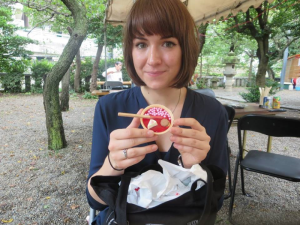Jessica Nash, a third year student at Western Carolina University, has always been interested in Japanese culture since she discovered what anime was.
“That was the door that introduced me to so many amazing and culturally pique things about Japan,” said Nash.

Jessica Nash, third year WCU student, is studying abroad at J.F. Oberlin University in Japan for one year. Photo provided by Nash.
To further explore the language, entertainment, anime, the way people live there and the city life of Japanese culture she decided to go and spend a year there.
“I came here to improve my Japanese language by being immersed into the language every day, but not only that. I wanted to experience the living style and culture on an everyday basis, first hand. Sometime in the near future I would like to live and work in Japan,” explained Nash in an email message.
Japan is a popular study abroad destination for WCU students.
“I have a total of 11 students studying at various universities in Japan for Spring 2016. Four of the 11 students studied in Japan Fall 2015, and seven will be studying for Spring 2016 only,” study abroad coordinator at WCU, Josie Bewsey, said.
There are many ways WCU students can study abroad. The program that Nash chose is called the RJ Program (Reconnaissance Japan). This is when students study for a year at J.F. Oberlin University, located in Machida, Tokyo, Japan.
According to WCU’s international programs and services website, in this program, students take a Japanese language course (which can be tested out of) and English-language courses in Japan culture and can stay at their choice of housing. Nash pays the tuition to WCU, but takes classes at Oberlin.
According to the school website, Oberlin is a private four-year university, located in a suburb of Tokyo called Machida. Reverend Yasuzo Shimizu founded it in 1946. It has a College of Arts and Sciences, three professional colleges, and a graduate division, as well. There are about 9,000 students enrolled there and many of them are from overseas. The school, according to the website, seeks “to foster global citizens on the basis of Christian values.”

Downtown Shinjuku Tokyo city. Photo provided by Nash.
Oberlin has basically the same essentials as WCU. According to Nash, the area is “convenient and beautiful.” There is a bus that takes students from the train station closest to the international students and dorms to the main campus. A convenient store resides on the campus, as well as a small gym, library and cafeteria. Even the classrooms are similar to WCU’s. They have desks, chairs, and the teacher still stands in front of the class. One main difference is that the doors slide open instead of pull open.
Nash’s day starts 14 hours earlier than in WCU because of the time difference.
“I am not taking very many classes. However, I have my main Japan language class everyday. I have three different Japanese teachers. Monday and Friday is the same, Tuesday and Wednesday is the same, and then Thursday. This is a bit different from the style of teaching in America. It was a little weird at first, but I got used to it,” said Nash.
There is a lunch period from 12:15 to 12:50, and Nash has many food options to choose from. Testing new foods is on the top of her “favorite things to do” list.
“Sometimes I bring a bento, [which is a] small boxed lunch from home, buy food from the convenience store, or go to a restaurant called Matsuja, which is very cheap, but also pretty good for the price,” Nash said.

Octopus and other eccentric Japanese foods. Photo provided by Nash.
When discussing food options, Nash explained that the convenient store on campus is one of the most popular place on campus to get lunch before or after class. There is a cafeteria, but there are no venues or places to eat at similar to the downstairs dining hall at WCU. There are cooks that actually make the food from a set menu (ramen, udon, curry, Japanese food, etc.) For how cheap the food is, Nash said it is really good.
Another difference is that Japan does not have as much land as America, so all the buildings seem to be built taller with several floors. This makes no difference for Oberlin University. The area is more congested and not as spread-out as a lot of campuses in America.
“One of the main buildings on Machida campus has 9 floors with elevators and an escalator,” explained Nash.
The landscape is different, but whether it is at WCU or Oberlin, Nash enjoys it.
“I went hiking a few times too, on Mount Takoa and Mount Ooyama and even visited Mount Fuji by bus. The views are amazing. I love the views at Western, but man, Japan is gorgeous. I could see the top of Mount Fuji from pretty much anywhere,” said Nash.
And although America will always house her family, her “home away from home” will remain in Japan.

Shinjuku Tokyo city. Photo provided by Nash.
“I want to live and work in Japan, so I definitely like Japan better than America. I like the convenience of the trains and convenience stores that are open for 24 hours. It’s beautiful. I love the city. There’s just something about the atmosphere that I love,” explain Nash.
Nash continues to have a great experience in Japan. Her Japanese has definitely improved a lot. She enjoys meeting all sorts of different people from different countries, not just from Japan. Nash is enjoying her time abroad and gaining an unforgettable experience. She is studying Japanese and commercial and electronic music. Her plan is to teach English in Japan for awhile and then eventually find something else. Nash is still debating if she will be back at WCU in the fall or stay abroad longer.



